Tri Lanka is Sri Lanka's first fully environmentally sustainable resort. Eight beautiful modern villas with living roofs of grasses and edible plants are built, entirely of recycled timbers and local stone, in a golden ratio spiral around the six-acre 2.5-hectare property. Take a video tour. Video: Tri Lanka
The first time I visited Sri Lanka, four years ago, I was smitten by the sensuality of this tear-shaped island of terraced tea plantations, dense jungles, empty beaches, vine-covered ancient ruins, king coconut groves, cinnamon forests, and the fragile beauty of its dilapidated colonial-era architecture.
I was not so smitten by the roads. Those days (and these) it could still take several hours to travel from Colombo to the highland tea plantations, a relatively short distance by Australian standards, on terrible thoroughfares, clogged with tuk-tuks, known as "three-wheelers" here, local buses blaring jangly music and trucks conveying elephants to new owners. There are new highways, built by Chinese chain gangs, but the hilly terrain still makes single-lane roads the norm.
So I am more than a little thrilled this time to find myself in an eight-seater seaplane soaring above Sri Lanka's troublesome roads and its jagged mountains, high enough to get a clear view of the Uluru of Sri Lanka, Sigiriya rock, with its monstrous carved lion's paws, once the site of the palace of mad King Kasyapa.
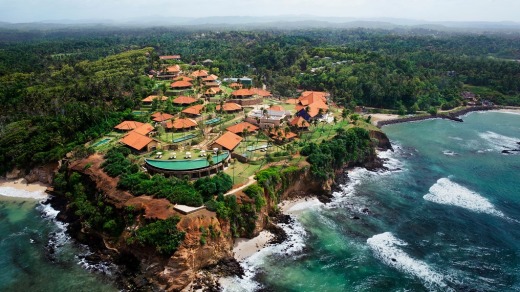
The Cinnamon Air Cessna 208 amphibian aircraft, expertly guided through the towering cumulous clouds by pilots in bare feet, lifts us over the mountains and waterfalls, and lands smoothly on glassy Castlereagh Lake in the central region of the fabled tea country. The exhilarating journey from Colombo's Bandaranaike airport takes all of 25 minutes.
Sri Lanka is changing, and most of it is for the best. There's great optimism about the new unity government, headed by President Sirisena, which last year saw off the repressive Rajapaksa regime in democratic elections, pledging an end to the cronyism, corruption and human rights abuses that has plagued the small country since the end of its 30-year civil war in 2009.
"The election was revolutionary," says Sandali Matharage, the young woman who is historian at Colombo's venerable Galle Face Hotel. "That was a big step forward for us."
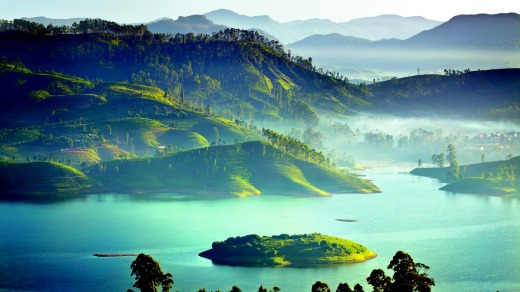
The brutal insurgency by the Tamil Tigers against the government left no winners: the United Nations deemed there were war crimes on both sides, with an estimated 40,000 Tamil civilians losing their lives in the final few weeks. "If there's a God, they [the Rajapaksa family] won't get back," a tourism operator tells me with fervour one afternoon in Colombo, echoing widespread sentiment.
The 2004 tsunami also left scars. In one village alone, about 200 children became orphans when their farmer parents were swept from a coastal market. Sri Lankan-born Australian celebrity chef Peter Kuruvita raised $25,000 for the children on one day through a charity effort at Flying Fish restaurant, which he once owned, in Sydney. While there have been generous cash donations from all over the world, Kuruvita, who visits Sri Lanka frequently working on projects with Dilmah tea, says much of it disappeared into the pockets of corrupt officials.
The coastal landscape is blemished with the carcasses of fishing boats thrown up by the tsunami and the mouldy ruins of foreshore houses, but otherwise, as with many countries that have a disturbing history, little of Sri Lanka's troubles are evident to the tourist, who is likely to be mesmerised by its profound beauty and charmed by its sweetly generous citizens.
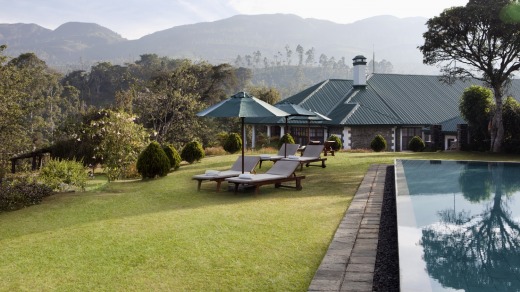
Still, there's a bit of evidence that there's a way to go – our driver is shaken down by police officers on the road to Galle, who fleece him of 2500 rupees (about $25), probably more than he'd make from the trip. Then again, the rich can no longer expect to escape fines when they break the speed limit in their flashy cars.
"Thirty years of war has been beautiful in some ways, because it kept Sri Lanka hidden," says Kuruvita. "This is the next destination."
Malik Fernando, the entrepreneurial younger son of Merrill J Fernando, the former tea taster who in 1962 established the company that later became Dilmah Ceylon Tea, says, "Sri Lanka is so undersold because of our problems". Malik, who is managing director of Resplendent Ceylon, the hospitality arm of Dilmah, launched Tea Trails luxury bungalows on the family's tea estate 11 years ago, and last year opened the sumptuous Cape Weligama on a dramatic cliff above a south coast surfing spot.
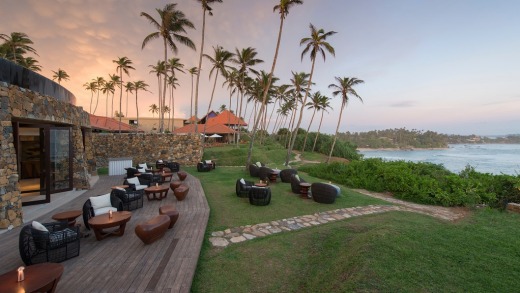
He has faith in Sri Lanka's potential as a luxury destination and believes the Cinnamon Air seaplane service, which can now "seamlessly" connect the tea plantations with the city and the beach, will be a huge boost to the country's tourism. It may not exactly represent a case of "bye bye backpacker" – they will still come for the beaches and inexpensive lifestyle – but Sri Lanka now offers some of the finest small hotels and resorts in the world.
Our seaplane lands below Summerville, one of the four former plantation managers' bungalows that have been turned into guesthouses in the midst of the working tea plantation at Tea Trails. The experience of staying in these gracious old colonial homes with their pools and croquet lawns and "bed tea" brought to you by a butler in the morning, has to rate as one of travel's most special moments.
I've stayed at Castlereagh and Norwood bungalows before, so this time I'm housed in the Fraser Garden Suite of the oldest bungalow, Tientsin, which dates to 1888. The other bungalows have a tranquil lakeside setting, but I prefer this old charmer, which exists in close proximity to the tea pickers' villages, so there's a fascinating cultural life nearby. Women carry cuttings from the tea bushes on their heads as they sashay through the monsoon-washed village; children chase you with bright smiles and the enthusiastic greeting, "welcome to Sri Lanka!" and music from a CD shop down below fills the air as we dine on the bungalow's terrace.
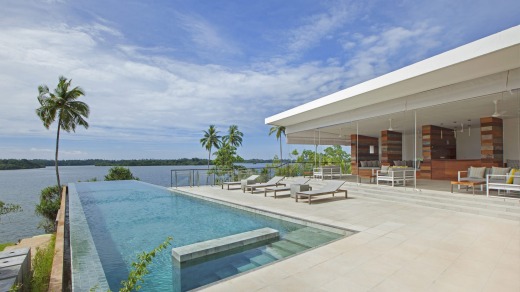
Each bungalow has six guest rooms and they're so popular that Malik's father, Merrill, tells me that even he can't get a room there. Accordingly, there's a new bungalow, Dunkeld, about to open, and plans for more to meet the demand.
If Tea Trails represents the accessible luxury of Sri Lanka's colonial past, then the just-opened eco resort Tri Lanka represents its future. Two days later, our seaplane takes off from Tea Trails and barrels into the gathering storm clouds (not as bumpy as one might expect) before landing a mere 20 minutes later on Koggala Lake, in the southern beachside district of Galle.
We're driven through air force barracks (there's still a strong military presence throughout the country) to a jetty where we're helped onto a fisherman's boat for the five-minute trip across the lake to the modernist Tri Lanka, which is set in a former cinnamon plantation surrounded by water.
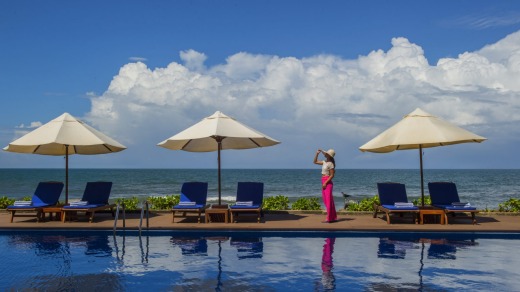
It feels very secluded: hardly another building in sight, except at night when you can see, from a fabulous lookout in the resort's central cinnamon stick-clad tower, the occasional illuminated house buried in the vegetation across the lake. Tri Lanka itself is Sri Lanka's first fully environmentally sustainable resort. Eight beautiful modern villas with living roofs of grasses and edible plants are built, entirely of recycled timbers and local stone, in a golden ratio spiral around the 2.5-hectare property.
It's the lovechild of Robert Drummond and Lara Baumann – he, a British-born language graduate who came to Sri Lanka in 2000 and settled in Galle Fort; she, a diplomat's daughter of German ancestry who is Sri Lanka's foremost yoga teacher and founder of Quantum Yoga, a dynamic form of yoga that incorporates Ayurvedic principles. (Bryan Adams, Russell Brand and Gerard Butler are among Lara's celebrity clients.)
I call Sri Lanka the "un-India" and Lara, who spent much of her childhood in Madras, agrees."It's a lot more user-friendly than India," she says. There's the clean water, which streams from the mountains after copious rains, the agricultural economy which means the country is relatively free of pollution, the abundant fish and health-giving produce, including king coconut, tea, and cinnamon, of which 95 per cent of the real stuff (we are often sold carcinogenic cassia instead) comes from Sri Lanka, and the Sri Lankan style of cooking, which is spicy, fast and fresh, using coconut oil rather than ghee, and utterly delicious.
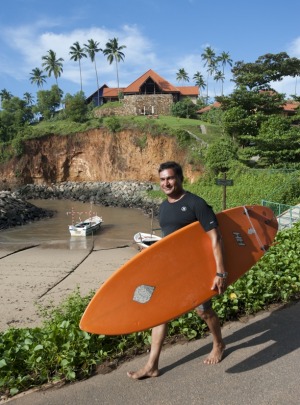
Tri Lanka is only one of a flurry of new upscale resorts in Sri Lanka. Anantara's first Sri Lankan resort opened last month and a 600-room Shangri-La is slated for 2016. "For 30 years everything was put on hold," Drummond says. "There were so few beds for luxury travellers. I used to know everyone who had boutique hotels.'' Not now.
A few well-known expats are among that group, including Australian Geoffrey Dobbs of the Dutch House and the Sun House near Galle Fort, who famously was expelled in 2013 for flying the Sri Lankan flag upside down. These boutique hotels, plus some stylish villa rentals, mitigated against Sri Lanka's reputation as a budget destination for Australian surfers and Israeli backpackers. Surfers still flock to beaches such as Arugam Bay (the best surf beach, if you don't mind crowded waves) and Hikkaduwa, but, as Kuruvita, who is a keen surfer, says: "the top end of surfing is alive and well. There are many well-heeled surfers who would love to surf here."
Kuruvita is fortuitously visiting Resplendent Ceylon's deluxe new Cape Weligama resort, south-east of Colombo, at the same time as me. He's there to finalise plans for a surfboard factory that will be built on a plot of land near the resort, sponsored by the Fernando family's MJF charitable foundation, which funds a number of effective humanitarian and environmental initiatives.
On previous visits, Kuruvita noted that the local kids, who hang out on the beach with little prospect of a future, surf on broken boards, bits of wood, anything floatable they can lay their hands on. There's nowhere locally to repair boards or produce new ones. This inspired him to think about starting a factory to teach the kids shaping and glassing, as well as administration and marketing skills.
His partner in the surfboard factory is Thomas Bexon, a shaggy-bearded Sunshine Coast boy who has a well-regarded eponymous shaping business in Noosa, specialising in long boards. Kuruvita, also Noosa-based, met Bexon when he came into the surfboard factory to have a haircut (yes, there's a barber shop in it too.) Bexon initially will be dividing his time between Australia and Sri Lanka and the factory should be fully operational at the end of 2016.
The kids who hang out at Jungle Beach (a hidden spot that nevertheless has a TripAdvisor rating) are ''rascals", Kuruvita says, but he has great empathy for them. Troubled as a youngster himself, he was saved from serious brushes with the law by being apprenticed in a kitchen in the nick of time. "This is about giving them a chance," he says. "Imagine the pride in making Sri Lanka's first surfboard!"
One of the issues the new Sri Lanka faces is a severe shortage of qualified people in industries from IT to hospitality. Service can be patchy. For decades, Sri Lanka has exported its workers to places like Dubai and Saudi Arabia and to the world's cruise ships. "The social impact on families is great," says Malik Fernando over dinner in Rouge, Cape Weligama's cliff-hanging steakhouse. "The mark of Sri Lanka maturing is that we can give jobs to all our people."
Many are returning home, at last. Further south at Amanwella, the Aman resort perfectly positioned on a secluded scythe of beach near Tangalle, we meet Radley Vandersay, the resort's Food & Beverage Manager, who is typical in that he has worked in Dubai, the Maldives and the Seychelles, nearby destinations offering steady work and bigger pay packets.
Aman boldly opened its two Sri Lankan properties in 2005, when skirmishes were still happening (although the war didn't affect tourists much, by all accounts). Amanwella, designed by the acclaimed Australian resort architect Kerry Hill, barely looks its age, built in a much-copied style of long, airy pavilions overlooking a 47-metre pool and a pretty beach with a coconut grove of lounge chairs where waiters bring sorbets and smoothies. It's very deluxe in a chic, minimalist, albeit very expensive, way.
On the other hand, Amangalla, in Galle Fort, represents pure colonial splendour. The former New Oriental Hotel, built by P&O in 1865 to house passengers visiting the 17th Century Dutch fort, has been immaculately restored, with the mod cons of spa, pool and Wi-Fi. Otherwise, sitting in a cane chair on its long front verandah, fluttering a straw fan, you could easily imagine yourself to be a tea trader from a hundred years ago, passing though Galle on your way to the plantations.
Galle Fort, protected from the Indian Ocean by high limestone and coral ramparts (it survived the tsunami because of them) houses much of Sri Lanka's Muslim population, descended from the Moor traders who established fisheries and gemstone businesses centuries ago. They have occupied the fort's beautiful (and sometimes dilapidated) Dutch houses for generations.
On one narrow street we meet a white-robed gentleman who is buying fish from a bicycle cart. His name is Shaffy, he tells us, and he was born in the fort. He invites us to visit his house, which he bought for 59,000 rupees ($590) in the 1970s. These days, the old houses are being bought up by expats, turned into boutiques and cafes, and can sell for upward of $1.3 million.
We return to Colombo on a Chinese-built new freeway that cuts a scenic route through cinnamon forests and rice paddies. There are big yellow signs warning "danger, peacocks ahead". The trip is traffic-free until we reach the chaotic outskirts of the capital, where we inch along in a Biblical-strength downpour.
On the Colombo waterfront, Galle Face Hotel, which dates to 1864, has just undergone an exacting restoration. Sri Lanka's colonial heritage is alive and well here. Each afternoon, the Sri Lankan flag that flies over the chequer-board terrace is taken down, folded up and removed by a gold-braided military official, accompanied by a bagpiper, a tradition dating to the 19th century.
It was the first place in Sri Lanka to receive an order of Pimm's and there are four kinds of Pimm's Cups on the drinks menu.
There is so much charm in this pearl of a country that many worry it will be spoiled. Where the rules once stated that no building could be taller than a coconut tree, there's the ugly new Marriott rising 11 storeys above Weligama Bay. It's so incongruous, people worry there will be more to come, although most point out that it was approved under the previous, reviled government. But right now and for some time to come, I hope, Sri Lanka is the un-India. It's the un-Bali too. If you like that thought, go now.
srilanka.travel
resplendentceylon.com
trilanka.com
amanresorts.com
gallefacehotel.com
SriLankan Airlines code shares with Qantas on flights to Colombo from Singapore. A resumption of direct flights to and from Melbourne have been earmarked for 2016 but for updates check with the airline. See qantas.com; srilankan.com
Only the foolhardy self-drive in Sri Lanka. King's Tours is a reliable service that provides drivers in a range of vehicles from limousines, jeeps and minivans to old Morris Minors. See kingstours.net
Cinnamon Air has more than 80 scheduled services a week. See cinnamonair.com
Colonial era tea planters' bungalows nestling in the lush tea plantations of the Central Highlands. Double luxury rooms from $US718, inclusive of meals, high tea, select wine and spirits, butler service and tea factory visit. See teatrails.com
Contemporary, eco-minded retreat with impeccable wellness credentials. Lake Suites, which feature lake view balconies and sun decks with plunge pools, start at $US343 low season, including breakfast and dinner for two. See trilanka.com
Supreme comfort, set in tropical gardens on a breathtaking headland. Prices start at $USD682 for two for 130-square-metre residences, including breakfast, afternoon tea, laundry, minibar and daily activities. See capeweligama.com
Stylish pavilions and villas occupying what may be the perfect, secluded beach. Spacious suites have plunge pools and terraces with views of the beach, ocean or coconut grove. Suites start at $A1817. See amanresorts.com/amanwella
Exquisitely-restored landmark hotel within the ramparts of Sri Lanka's most fascinating city. Ayurvedic treatments, pool in a garden setting with luxurious cabanas, yoga pavilion. Double rooms start from $USD 1774. See amanresorts.com/amangalla
Grand Dame of the Orient, now beautifully restored, on Colombo's seafront. A number of water-view dining options available, swimming pool, croquet lawn, sundowners and high tea. Superior rooms start at $US166. See gallefacehotel.com
Sri Lanka's gem mines have been renowned for centuries. The star sapphire is its most famous gemstone, but most semi-precious stones are excellent value. Galle Fort is a good location for buying gemstones and jewellery.
On the Dilmah Estate, Central Highlands, where you'll find out all about the picking and drying process and the antioxidant properties of this miracle brew. Sri Lanka is the world's biggest exporter but only Dilmah produces 100 per cent Ceylon tea.
Anuradhapura is one of the ancient capitals of Sri Lanka, founded in the 5th century BC, now one of Sri Lanka's eight UNESCO World Heritage sites. It's far less crowded than Angkor Wat in Cambodia.
Amidst the chaos of the Pettah produce and clothing market in Colombo, stalls sell spices and Ayurvedic medicine, and the trashier barns are full of kitchenware and cheap clothing. The Muslim enclave has some striking architecture and mosques.
Be one of the 100,000 pilgrims who ascend 2243-metre-high Adam's Peak every day to worship the Footprint of the Buddha, or (for something a little less challenging) climb dizzying Sigiriya Rock to stand atop the ruins of a palace built around 495 BC by a king who was afraid of heights.